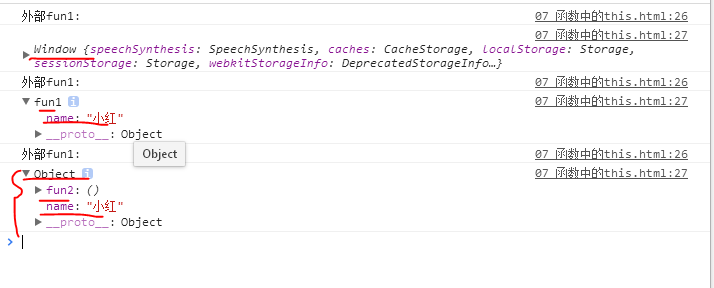一.函数
1.函数是什么
- 具有特定功能的n条语句的封装体。
- 只有函数是可执行的,其它类型的数据是不可执行的。
- 函数也是对象。
2.为什么要用函数
- 提高代码复用
- 便于阅读和交流
3.如何定义函数
- 函数声明
- 表达式
1 function fun1(){ 2 console.log("函数声明定义函数"); 3 } 4 5 var fun2 = function(){ 6 console.log("表达式定义函数") 7 }
4.如何调用函数
- test()
- new test()
- obj.test()
- test.call(objx)/test.apply(objx)
1 function fun(){ 2 console.log("fun执行"); 3 } 4 5 //1.函数自调用,相当于window.fun()调用方式 6 fun(); 7 8 //2.回调函数:事件回调,定时器回调 9 document.getElementById("btn").onclick = function(){ 10 console.log("事件回调"); 11 } 12 13 setTimeout(function(){ 14 console.log("定时器回调"); 15 },1000); 16 17 //3.构造函数:实例化对象调用(this指向当前构造函数的实例对象) 18 function Person(name,age){ 19 this.name = name; 20 this.age = age; 21 } 22 23 var person1 = new Person('小红',17); 24 25 //4.call,apply强制绑定this 26 var obj1 = {name:"obj1"}; 27 function fun2(){ 28 console.log(this);//用于输出当前this所绑定的对象 29 } 30 31 fun2(); //this = window 32 fun2.call(obj1); //this = Object {name: "obj1"} 33 fun2.apply(obj1); //this = Object {name: "obj1"}
5.回调函数
(1)什么函数是回调函数
- 你定义的
- 你没有直接执行
- 最终他执行了(在特定条件下)
(2)常见的回调函数
- DOM事件函数
- 定时器函数
- ajax回调函数
- 生命周期回调函数
1 document.getElementById("btn").onclick = function(){ 2 console.log("DOM事件回调"); 3 } 4 5 setTimeout(function(){ 6 console.log("定时器回调"); 7 },1000);
6.IIFE
全称: Immediately-Invoked Function Expression
别名:函数自调用,立即执行函数,IIFE
特点:
- 只执行一次
- 代码执行到函数是,此函数就执行了
- 函数的数据是私有的
7.this
- this是关键字,不能用来定义对象
- this本身是一个内置的变量,该变量指向一个对象
- this有两种:
- 全局this:指向window
- 局部(函数)this:指向它的调用者(例如:构造函数的this指向实例对象)
- 特殊this:call,apply强制修改this
1 function fun1(){ 2 3 console.log("外部fun1:"); 4 console.log(this); 5 this.name = "小红"; 6 7 } 8 9 var obj = { 10 fun2: function(){ 11 console.log("内部fun2:"); 12 console.log(this); 13 } 14 } 15 16 window.fun1(); // this = window 17 new fun1(); // this = 实例对象(fun1{}) 18 fun1.call(obj); //this = obj
注:使用new 操作符执行步骤:
语法:new fun1();
- 创建空对象
- 执行函数
- 确认this指向
- 返回执行结果:fun1{} 给空对象

此图可以看出new fun1();首先创建一个空对象去指向这个fun1,再给予this的name属性创建并赋值。